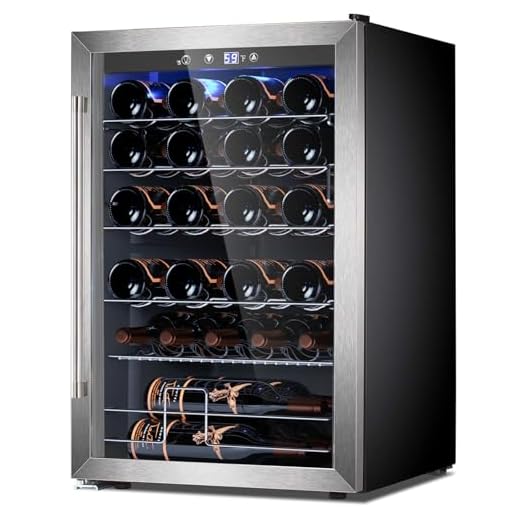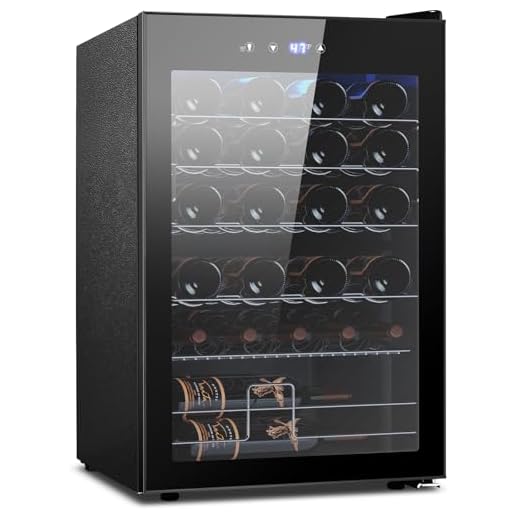



For optimal preservation, aim to keep your cherished bottles at a consistent range of 55°F to 65°F. This specific range allows the complex flavors and aromas to develop gracefully over time without compromising quality.
In addition to temperature, it’s crucial to maintain stable conditions. Fluctuations can lead to premature aging or spoilage. A dedicated storage unit or a wine fridge is ideal, as it ensures that your selections remain at the desired warmth.
Humidity levels also play a significant role. Keeping the environment around 70% helps prevent corks from drying out, which can lead to oxidation. Ensuring your collection is in a dark location, away from direct sunlight, further protects it from degradation.
Remember, patience is key. Allowing your selections to rest in these ideal conditions will enhance their character and ensure a delightful tasting experience when the time comes to indulge.
Optimal Conditions for Storing Your Favorite Bottles
For ideal preservation, aim for a range between 55°F and 65°F. This range allows the complex flavors to develop while minimizing the risk of spoilage. Consistency is key; fluctuations can disrupt the aging process and alter the character of the beverage.
Humidity and Light Considerations
Maintain humidity levels around 60-70% to prevent corks from drying out, which can lead to oxidation. In addition, keep your collection away from direct sunlight and strong artificial lighting, as these can degrade quality over time.
Vibration and Air Quality
Avoid areas prone to movement or vibration, as this can disturb sediment and affect taste. Ensure your storage space has good air circulation, minimizing exposure to strong odors that could permeate through the cork.
Optimal Temperature Range for Red Wine Storage
For the proper preservation of your collection, aim to maintain a range between 50°F and 65°F (10°C to 18°C). This allows for the best flavor development and aging potential.
Ideal Conditions
Alongside the temperature, ensure consistent conditions. Fluctuations can harm the quality. A stable environment will support the integrity of the liquid.
Humidity Considerations
Maintain a humidity level between 50% and 70%. This prevents corks from drying out or becoming overly saturated, both of which can compromise the seal and introduce unwanted elements.
| Condition | Recommended Range |
|---|---|
| Temperature | 50°F – 65°F (10°C – 18°C) |
| Humidity | 50% – 70% |
Adhering to these guidelines will enhance the longevity and enjoyment of your selections. Remember, the right environment is key to achieving the best experience with each bottle you open.
Impact of Temperature on Wine Flavor and Aroma
The ideal storage conditions profoundly influence the profile of any bottle, particularly with varietals that benefit from nuanced expressions. Fluctuations in warmth can accelerate chemical reactions, leading to unwanted alterations in taste and scent. For instance, higher levels can hasten the aging process, potentially causing premature oxidation, which diminishes complexity and results in flatness.
Cooler environments preserve freshness and enhance the intricate notes found in quality selections. This stability allows for the gradual development of flavors, including the evolution of fruit characteristics and secondary aromas such as spice or earth. A consistent climate promotes a balanced maturation, crucial for achieving a wine’s full potential.
In essence, the environment in which a bottle is kept dictates its trajectory. Maintaining an appropriate range not only sustains original attributes but also ensures the integrity of the bouquet and palate. A well-cared-for bottle reveals its true character, offering a rewarding tasting experience that reflects the terroir and craftsmanship of its creation.
How to Achieve Consistent Storage Temperature
For optimal preservation, aim for a stable environment ranging from 55°F to 65°F (13°C to 18°C). Fluctuations can damage the liquid, so implementing a dedicated cooling unit is advisable. These units maintain an even climate, preventing temperature spikes from external sources.
Location Matters
Keep your bottles away from direct sunlight and heat sources. A dark, well-ventilated cellar or a specialized wine fridge is ideal. Ensure the area remains insulated to shield against outside conditions, particularly in regions with extreme weather.
Regular Monitoring
Use a thermometer to check conditions regularly. Digital models that record high and low extremes provide valuable insights. Pair this with a hygrometer to monitor humidity levels, which should be around 50-70%. Maintaining balance here is crucial for cork integrity.
For those looking to expand their culinary skills, you might find this guide on how to cook lasagna in air fryer quite useful.
Best Storage Conditions for Different Types of Red Wine
For optimal preservation, full-bodied varieties like Cabernet Sauvignon and Syrah thrive in a climate of 55°F to 65°F, allowing their rich flavors to develop gracefully over time. On the other hand, lighter styles such as Pinot Noir and Gamay can benefit from slightly cooler settings, ideally between 50°F and 60°F, which helps maintain their delicate aromas and freshness.
Special Considerations for Aging
Aging potential plays a crucial role in storage. Wines with higher tannin content, such as Barolo and Bordeaux, require a stable environment to mature appropriately, avoiding fluctuations that can hinder their evolution. For these bottles, maintaining consistent conditions around 55°F is advisable.
Short-Term Storage Recommendations
If enjoying selections within a year or two, a range of 60°F to 65°F is acceptable for everyday varietals. These wines, such as Merlot or Zinfandel, can be more forgiving with minor variations in conditions, allowing for greater flexibility in storage options.
Signs That Your Beverage is Kept at the Wrong Temperature
Look for these indicators to determine if your collection isn’t in ideal conditions:
- Off aromas: If you notice unusual or rancid scents, it may indicate spoilage due to excessive heat.
- Muted flavors: A flat or dull taste can signify that the drink has been subjected to inappropriate warmth.
- Color changes: A shift in hue, especially for reds becoming overly brown or light, suggests degradation.
- Cork issues: A pushed-out cork or leakage can indicate expansion from heat exposure.
- Sediment formation: Unusual sediment may form when a bottle is subjected to fluctuating conditions.
- Cloudiness: An unclear appearance can point to spoilage, often linked to high storage warmth.
- Carbonation loss: For sparkling varieties, diminished bubbles may arise from improper conditions.
Monitoring these signs can help maintain the integrity of your collection. Regular checks will ensure that you enjoy each pour to its fullest potential.
Common Mistakes in Wine Storage Temperature
Storing bottles at fluctuating degrees is a frequent error. Consistency is key; avoid placing your collection near appliances that generate heat. A stable environment prevents premature aging and maintains integrity.
Another misstep is using the refrigerator for long-term preservation. While a fridge can chill, it’s often too cold and dry, which can damage corks and affect flavor profiles. Instead, opt for a dedicated unit that mimics cellar conditions.
Many individuals overlook the impact of sunlight exposure. UV rays can degrade the liquid, leading to undesirable changes. Always keep your bottles in a dark space or use opaque containers if light exposure is unavoidable.
Some enthusiasts incorrectly assume that all varieties require the same conditions. Each type has unique needs; understanding these can significantly enhance the tasting experience. Tailor your approach based on the specific characteristics of the varietals you possess.
Lastly, neglecting humidity levels can also be detrimental. Low humidity can dry out corks, allowing air to seep in and spoil the contents. Aim for a balanced humidity level to protect your investments.
Tools for Monitoring Wine Storage Temperature
Investing in reliable equipment for tracking the environment where your bottles rest is paramount. Here are some key devices to consider:
- Digital Thermometers: These provide accurate readings and often come with features like memory recall and high/low temperature alerts.
- Wi-Fi Enabled Sensors: These allow remote monitoring via smartphone apps, ensuring you can check conditions from anywhere.
- Thermo-Hygrometers: In addition to temperature, these instruments measure humidity levels, which is crucial for optimal cork integrity.
- Data Loggers: For those serious about tracking fluctuations over time, these devices log temperature data at set intervals, allowing for thorough analysis.
- Smart Wine Fridges: These appliances often include built-in monitoring systems, maintaining the ideal environment automatically.
Regularly checking and recording the readings from these tools will help ensure your collection is preserved in the best possible condition. Adjusting storage solutions based on the data collected can significantly enhance the longevity and quality of your collection.









